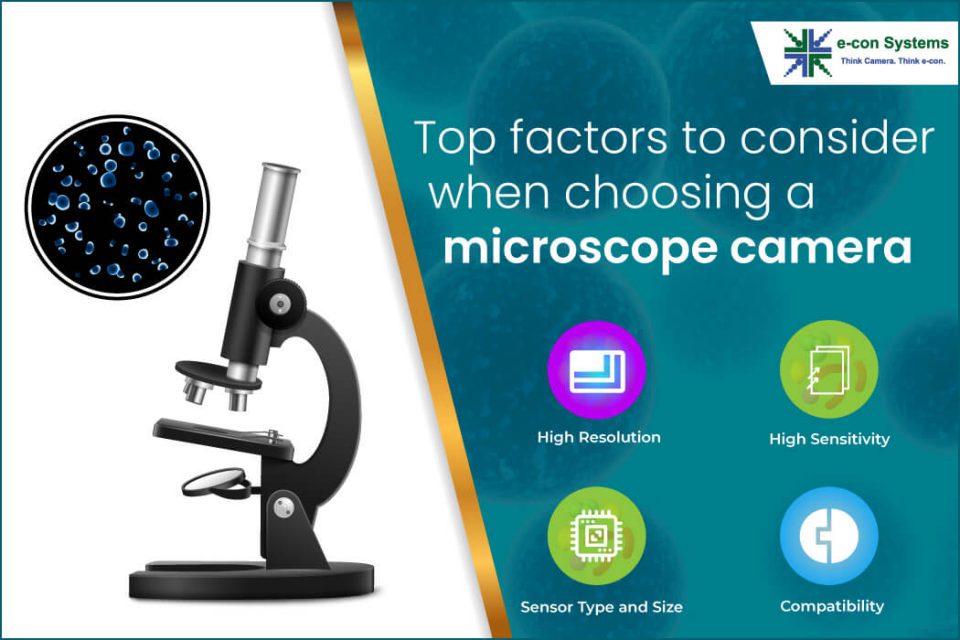Recent years have seen rapid developments in how effectively embedded vision applications capture and process microscopic images in the medical and life science industry. However, perfectly capturing greater details involves choosing the camera with the right sensor type and size, noise level, sensitivity, resolution, readout speed, and so on.
In this article, let’s take a detailed look at the factors to be considered while choosing a microscope camera and how these can impact the overall performance of your application.
What is a microscope camera?
A microscope camera is a specialized camera that is designed to be used with a microscope. It is used to capture high-resolution images or videos of microscopic samples, which can then be analyzed, studied, and shared. There are several types of microscope cameras available, including digital cameras that can be attached to a microscope’s eyepiece. Other cameras can be built directly into the microscope itself. They can also come with software that allows for advanced image processing and analysis.
What are the top factors to consider when choosing a Microscope Camera?
High Resolution
Camera resolution indicates the level of detail that can be delivered. So, if your microscope needs to capture an image of cell structures, tissues, or organisms without losing image quality, you must consider your camera resolution in relation to microscope resolution. Furthermore, the required pixel size of the camera is hugely reliant on the resolution and magnification of the microscope objective. However, if the microscope camera resolution is way too high, you end up wasting a lot of pixels and storage space. On the other hand, if the camera resolution is low, then it can’t capture more detail for lower magnification. Finally, you end up replacing the camera with a high-resolution variant. Consequently, you need to ensure that the camera you pick can meet the desired resolution.
High Sensitivity
Microscope camera with high sensitivity plays a vital role in fluorescence microscopy applications. This factor helps to avoid photobleaching your sample. In addition, a microscope camera with high sensitivity is crucial for precisely capturing high-quality images of biological samples even in low light conditions. Quantum efficiency (QE) is the sensor’s ability to convert photons into electrons – directly relating to sensitivity. The QE increases with the increase in the light-sensitive portion of the sensor. Moreover, the recent advancements in sensor technology, such as wider incident angles and larger depths of photodiodes can enhance the sensitivity further.
Find out how high-sensitivity cameras improve digital microscopy imaging and their use cases – with exclusive details on how e-con Systems’ all-in-one camera – the See3CAM_50CUGM – is a perfect fit for digital microscopes. Read more: https://www.e-consystems.com/blog/camera/applications/how-high-sensitivity-cameras-can-improve-imaging-in-digital-microscopy/
Camera Noise
Camera noise is classified into three types: dark noise, read noise, and shot noise. Microscope cameras with low read and dark current noise are in high demand in fluorescence microscopy because they produce clearer images and can benefit from the higher gain. The lower the read noise, the higher the gain that can be employed without degrading image quality.
Sensor Type and Size
The perfect choice of sensor type and its size provides a greater level of detail in the capture of living cells and tissues. This allows a more accurate analysis of cellular processes. Image sensors such as CMOS and CCD are available with different specifications in industries today. But CMOS sensors outperform older CCD sensors in every way and are a more cost-effective option. The CMOS sensors, such as the Sony STARVIS series or Pregius series, come with excellent features like a global shutter, superior NIR imaging performance, high quantum efficiency, etc. In addition, a microscope camera with global shutter features enables distortion-free images, which is particularly useful in fluorescence and live cell imaging.
Also, choosing a large sensor compared to a small sensor enhances the camera’s ability to capture low-light images as it contains larger photosites. Large sensors tend to have large pixel sizes, indicating higher sensitivity and achieving higher resolution.
Compatibility
The microscope camera connected through USB can provide a live view on the computer screen. This USB microscope camera can be attached to a phototube instead of an eyepiece. Many microscope cameras now support UVC. As a result, video streaming through UVC is possible without additional drivers on operating systems that include built-in support for UVC standards.
Camera solution for Medical Microscope to Improve the Accuracy & Speed of Diagnosis
e-con Systems’ latest See3CAM_50CUG camera for medical and life science applications
See3CAM_5OCUG – 5MP Sony® Pregius IMX264 Global Shutter Color Camera designed by e-con Systems for applications like Digital Microscopy, Fluorescence Imaging, Live Cell imaging, Point of Care diagnostic devices, Ophthalmic Devices, Molecular Imaging, ITS, Drones and Factory Automation. This 5MP high-sensitive color camera leverages the Sony Pregius IMX264 CMOS sensor for exceptional image quality and accuracy. Some of its features include:
- Global shutter technology
- High dynamic range
- High frame rate
- IR sensitivity
- C-mount lens holder
- High SNR
You can also check out our Camera Selector page to see our entire portfolio of cameras.
If you require assistance with integrating camera solutions into your vision-based application, please email us at camerasolutions@e-consystems.com.

Balaji is a camera expert with 18+ years of experience in embedded product design, camera solutions, and product development. In e-con Systems, he has built numerous camera solutions in the field of ophthalmology, laboratory equipment, dentistry, assistive technology, dermatology, and more. He has played an integral part in helping many customers build their products by integrating the right vision technology into them.




